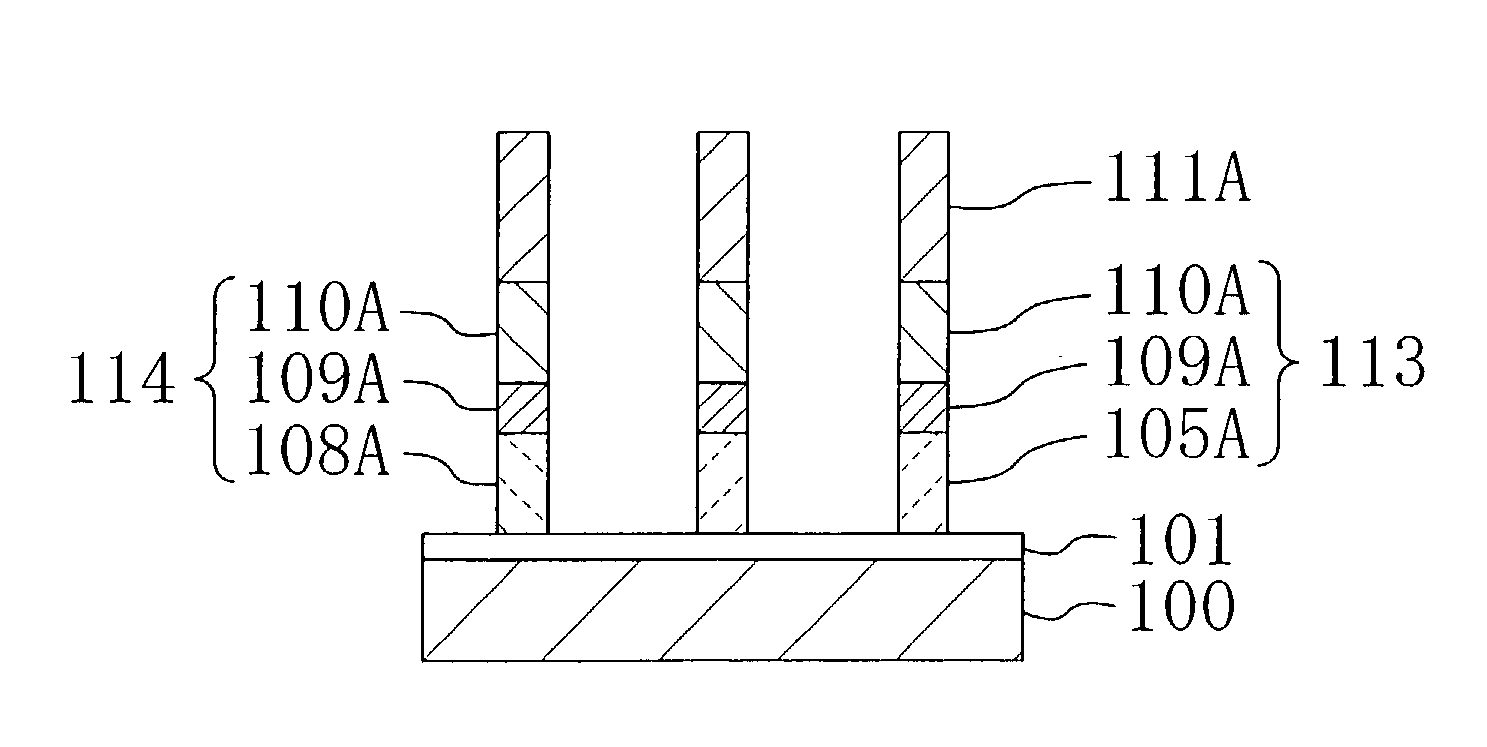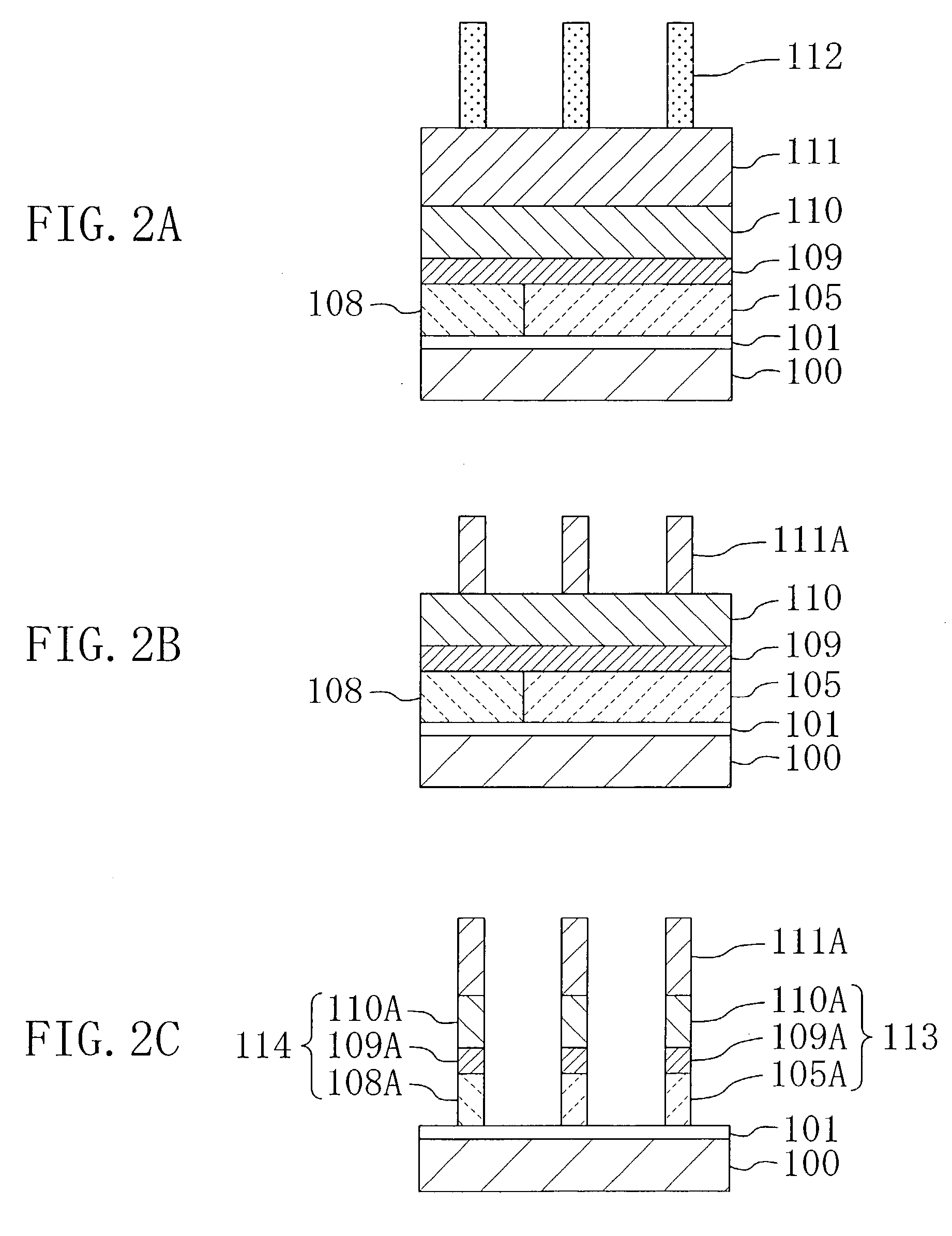Method for fabricating semiconductor device
a semiconductor and fabrication method technology, applied in the direction of semiconductor devices, electrical devices, transistors, etc., can solve the problems of excessive etching of silicon film, excessive etching inability to increase the etching rate of titanium fluoride and titanium oxide, so as to reduce the number of grain boundaries formed
- Summary
- Abstract
- Description
- Claims
- Application Information
AI Technical Summary
Benefits of technology
Problems solved by technology
Method used
Image
Examples
embodiment 1
[0078]A method for fabricating a semiconductor device according to Embodiment 1 of the invention will now be described with reference to FIGS. 1A through 1D and 2A through 2C. In Embodiment 1, an implanted impurity is prevented from depositing in a grain boundary of a silicon film of a polymetal structure.
[0079]First, as shown in FIG. 1A, a gate insulating film 101 of a silicon oxide film with a thickness of, for example, 3 nm is formed on a semiconductor substrate 100 of silicon or the like by, for example, thermal oxidation. Thereafter, a polysilicon film 102 with a thickness of, for example, 100 nm is deposited on the gate insulating film 101 by, for example, CVD.
[0080]Next, as shown in FIG. 1B, after forming a first resist pattern 103 in a first predetermined portion on the polysilicon film 102, a group V impurity 104 of phosphorus (P) or the like is implanted into the polysilicon film 102 by ion implantation at a dose of, for example, 5×1014 / cm2, so as to form an n-type polysil...
embodiment 2
[0127]A method for fabricating a semiconductor device according to Embodiment 2 of the invention will now be described. As a characteristic of Embodiment 2, in the case where a group V impurity is deposited in a grain boundary of a polysilicon film included in a polymetal structure, chlorine is included in an etching gas used for removing a residue of a barrier film and a natural oxide film present on the polysilicon film. The conditions for the etching of a tungsten film 110 and a tungsten nitride film 109 and the conditions for the main etching and the over-etching of an n-type polysilicon film 105 and a p-type polysilicon film 108 are the same as those employed in Embodiment 1. Accordingly, three conditions for removing the residue and the natural oxide film alone will be herein described.
[0128](1) First conditions employed when the etching gas is a mixed gas of Cl2 and HBr:
[0129]Pressure: 0.4 Pa
[0130]First RF power: 400 W (13.56 MHz)
[0131]Second RF power: 60 W (13.56 MHz)
[0132]F...
embodiment 3
[0162]A method for fabricating a semiconductor device according to Embodiment 3 of the invention will now be described. As a characteristic of Embodiment 3, in the case where a group V impurity is deposited in a grain boundary of a polysilicon film included in a polymetal structure, an etching gas used for removing a residue of a barrier film and a natural oxide film present on the polysilicon film is a mixed gas of a gas including chlorine and a fluorocarbon gas. The conditions for the etching of a tungsten film 110 and a tungsten nitride film 109 and the conditions for the main etching and the over-etching of an n-type polysilicon film 105 and a p-type polysilicon film 108 are the same as those employed in Embodiment 1. Accordingly, conditions for removing the residue and the natural oxide film alone will be herein described. In this embodiment, a Cl2 gas is used as the gas including chlorine, and a CF4 gas is used as the fluorocarbon gas.
[0163](1) Conditions for removing residue ...
PUM
| Property | Measurement | Unit |
|---|---|---|
| temperature | aaaaa | aaaaa |
| width | aaaaa | aaaaa |
| thickness | aaaaa | aaaaa |
Abstract
Description
Claims
Application Information
 Login to View More
Login to View More - R&D
- Intellectual Property
- Life Sciences
- Materials
- Tech Scout
- Unparalleled Data Quality
- Higher Quality Content
- 60% Fewer Hallucinations
Browse by: Latest US Patents, China's latest patents, Technical Efficacy Thesaurus, Application Domain, Technology Topic, Popular Technical Reports.
© 2025 PatSnap. All rights reserved.Legal|Privacy policy|Modern Slavery Act Transparency Statement|Sitemap|About US| Contact US: help@patsnap.com



